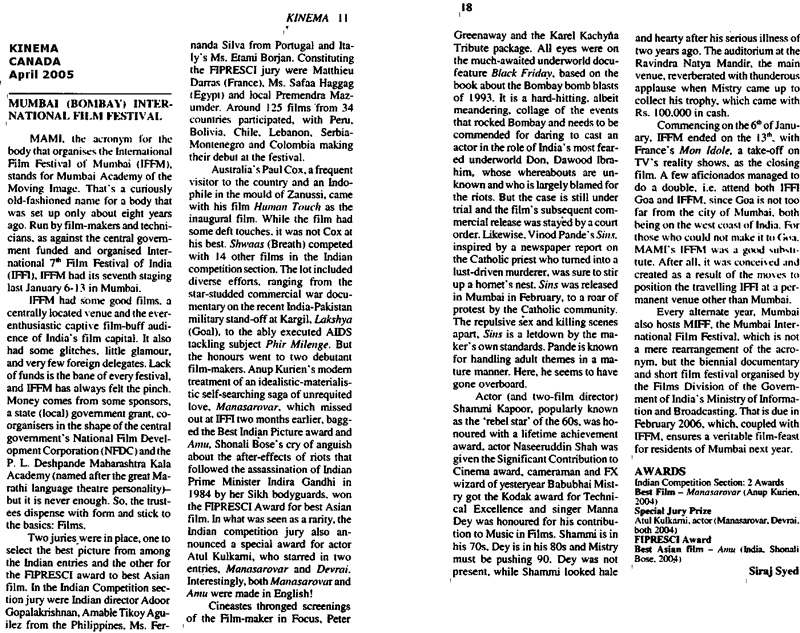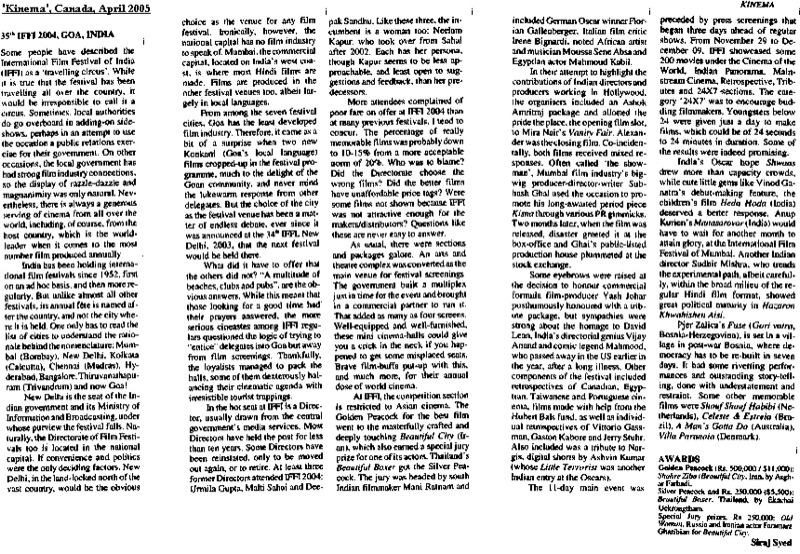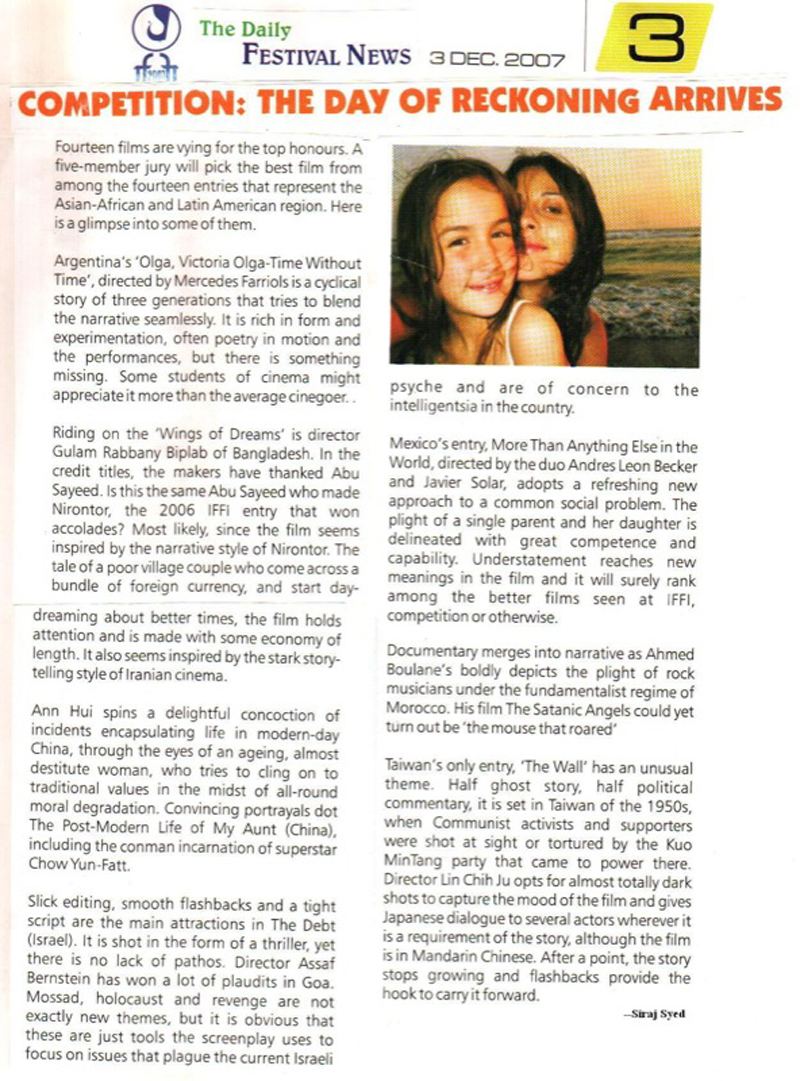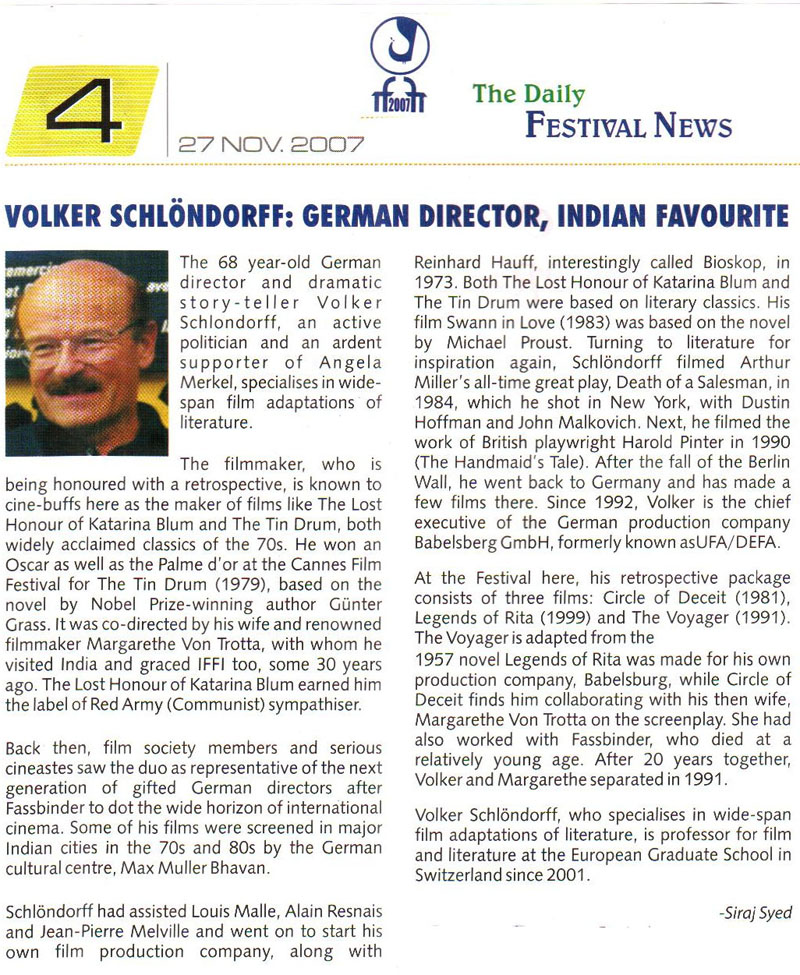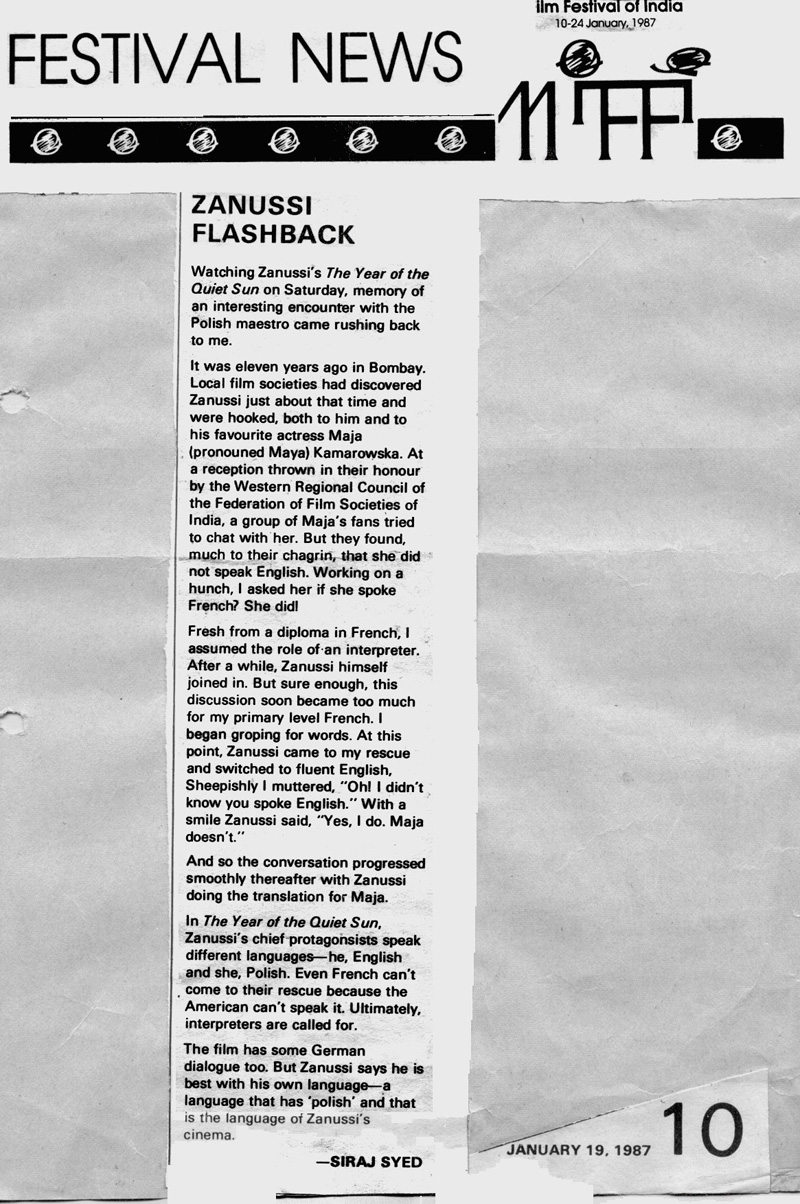|
|
||
|
Pro Tools
FILMFESTIVALS | 24/7 world wide coverageWelcome ! Enjoy the best of both worlds: Film & Festival News, exploring the best of the film festivals community. Launched in 1995, relentlessly connecting films to festivals, documenting and promoting festivals worldwide. Working on an upgrade soon. For collaboration, editorial contributions, or publicity, please send us an email here. User login |
SkyForce, Review: May the Force be with you
SkyForce, Review: May the Force be with you That is more like it. When you are making a film about war and real wartime heroes, stick to the basics and let jingoism take a back seat. We have had more than our fair share of war movies, with Indo-Pak conflicts dominating the screen. Many have set their tales in British India, going back up to 200 years. Yet others have flashed back a good 1,000 years, to reawaken the history of Muslim/Mughal rule over our country. SkyForce narrates the story of more recent conflicts, and that can only mean wars with China and Pakistan, as we have had no conflicts with our other neighbours. The base is that Pakistanis are rogues and pests, who are trying to snatch Kashmir away from India. In what comes down to “the mouse that roared,” they have been taught several lessons by big cat India. And yet, a substantial part of Kashmir remains under Pakistani possession. Two of the skirmishes against Pakistan took place in 1965 and 1971. And the two instances are recaptured here from the perspective of the Indian Air Force and a squadron located in Punjab. The film has its flaws, but manages to tell its story with sharp focus on the meat of the tale, doing away with side-tracks, blood curdling, sloganeering, flag-waving and trivialisation, and, therefore, deserves a watch. It is easy to take sides and portray the enemy as villainous scum. But it takes guts to accept that, except for the uniform, the values of nationalism and patriotism are as strong on the other side. SkyForce takes this realistic path and thus appears fresh in its approach. It does not get into war cries, head count and victor-vanquished territory. Instead, it tells the tale of a bunch of air force officers, who engage in attacks and counter-attacks several thousand feet above sea-level, well aware that each mission could be their last one. They have also made a pact with death, and do not fight shy of laying their heads on the line when duty beckons. Some of them have human frailties, like jealousy, but it never boils over into personal confrontation. The entire team has supreme faith in their Wing Commander, and he never lets them down. They also have a credo, “We do not leave any one behind,” which means that they will bring back their fellow pilots to their homeland, dead or alive, a dogma that lies at the crux of the film. It is 1965, and Wing Commander K.O. Ahuja has under his wing a band of blood brothers called the Tiger Squadron, who can perform miracles, even with basic, outdated Mystère aircraft. They include Taby, a rebel, who loves to bend the rules and orders, albeit with his mind trained on outsmarting the enemy. He is young, recently married, and about to become a father. Taby reveres Ahuja, who sees in Taby the image of Monu, his own brother, who lost his life in the line of duty. On one sortie, in the 1965 battle, Taby’s plane is hit and damaged. He is also pulled up for not following orders. Six years later, in 1971, Pakistan, challenges India again. Although the main battle was raging at the border of East Pakistan, the war had opened many new fronts, including one in Punjab (Pakistan has a province called Punjab, truncated from the undivided entity by the British in 1947). In the retaliatory attack of 1965, Taby is kept on stand-by, a move initiated by Ahuja’s superior, Lawrence, on account of his maverick moves on earlier occasions. Although Ahuja is upset with this decision, he obeys orders and marks number 13 against Taby, with 12 aircraft to fly in 3 formations of four each. The operation is named SkyForce. In a way, this fact happens to fulfill Ahuja’s promise to Taby’s pregnant wife that he will not let anything happen to Taby. If he does not fly, he is grounded and safe. The squadron takes off without Taby, but the last 4 planes face a thick dust cloud, preventing them from seeing anything and hindering their take-off. In a master-stroke, Taby gets into a jeep and trains its headlights on the runway, enabling them to take off. But he does not stop there. He gets into his plane, and soars right up, to join his team, a bit late though. Unfortunately, he does not come back. It is not clear whether he is alive or dead, and if he is alive, where is he. Six years later, a Pakistani prisoner of war, pilot Ahmed Khan, is interrogated by Ahuja, who learns that the PoW had been awarded a Medal by the Pakistani government for shooting down a Mystère plane. Could that have been Taby’s fighter jet? If so, could Khan possibly know what happened to Taby It is interesting that the writing credits include American black writer Carl Austin, who wrote the UK film, Provoked, directed by Jagmohan Mundhra, starring Miranda Richardson and Robbie Coltrane. He also collaborated with Mundhra on Natasha (2007) and Shoot on Sight (2007). In 2011, he co-wrote the Indian romantic thriller, Mausam, with director Pankaj Kapur. Mausam too had the air-force as its backdrop. Austin is one of four writers who have collaborated on the script of this film, the other three being co-director Sandeep Kewlani, Aamil Keeyan Khan and Niren Bhatt. Kewlani and Khan co-wrote Runway 34, (obviously) an aviation film. Khan also co-wrote Bhola, a singular credit, while he shared writing credit for Drishyam 2 with Abhishek Pathak. Niren Bhatt spread Sarkate ka Aatank in Stree-2, and wrote the hair-raising comedy, Bala, both as solo writer, and also penned Bala. Now that is as varied a team as you can get. The best part is that it largely delivers, and does not turn out patchy or choppy. Retaining focus and eschewing digressions, are the hallmark of the film’s screenplay. Being a drama about aeronautics and war casualties, neither aerial acrobatics nor weepy martyrdom encapsulate the flow of the story’s thread-line, although both options stare in the face of the writers. There are some points that seem to have been left unattended. Often, a soldier salutes a superior, who is seated, and the superior neither returns the salute nor responds with his own salute. This maybe the protocol, but it seems ungainly on screen. It is not explained why Ahuja had to tour several countries, while the search for Taby should have pointed at and ended at Pakistan. Taby’s wife’s reactions on learning that her husband went missing in action are depicted in the right measure. Taby’s limited on screen time is also in keeping with the thrust of the tale, which is not about his heroics, but about the effort to trace him and give him his due place in the war credits. Back-stories are strictly no-no, and we love is that way. Real footage is used with discretion, blending in with the fictionalised narrative seamlessly. Kudos to the team for showing us how prisoners of war should be treated, and acknowledging the former PoW’s good deed as it was, without trying to take credit away from him for his honourable gesture. Directors Sandeep Kewlani and Abhishek Anil Kapur have not pandered to the gallery. Viewers are not likely to jump up and down with war-cries, baying for Pakistani blood. On the contrary, they might find that a segment of the audience considers their balanced approach as not patriotic and nationalistic enough. The sanitised item song was unnecessary. Seeing a title card of the music company Saregama in the opening credits, one had to wait till the very end to hear Lata Mangeshkar sing ‘Aye merey vatan key logo’, composed by C. Ramchandra and written by Pradeep, a song that had Pandit Jawaharlal Nehru, the then Prime Minister of India, in tears, back in the 60s. It has had more than 85 million views on YouTube already. The song is used with breaks filled in by fresh inserts, which the makers could have done without. Thankfully, though, they have not tampered with the immortal song itself. Casting is of a high order, and the absence of too many stars does not jar at all. Born in 1971, the year of the big Indo-Pak war, 53 year-old Abhishek Anil Kapur was associate director in Bala and Stree 2. For Kewlani, SkyForce is his directorial debut. Having done a slew of movies in army uniform, Akshay Kumar walks through this role as Ahuja with honours. All the action he performs is from the inside of a fighter plane—no fisticuffs and stunts. That makes room for emoting and polish. Debutant Veer Pahariya, as Taby, acquits himself well. For a few years now, he has been watching the real thing from behind the camera, as an assistant director. Acting as slapdash as required, he will endear himself as a brave-heart who gave his country all he could. As Taby’s wife, Sara Ali Khan continues to do non-glamorous roles as easily as she did the glam-sham stuff. Nimrat Kaur is quietly dignified as Mrs. Ahuja. Sharad Kelkar impresses as Ahmed Khan. SkyForce has in its cast Manish Chaudhari as Ahuja’s boss Lawrence, Leena Sharma as Mrs. Lawrence, Varun Badola as a top-ranking Air Force official, and Mohit Chauhan. Whether it is the basic images for the VFX team, or real-time happenings, cinematographers Santhana Krishnan and Ravichandran have the right lenses for the job. Veteran A. Sreekar Prasad has the pulse of his audience on the console. Music by Tanishk Bagchi and the background score by Justin Varghese make their presence felt. SkyForce might have lost a few opportunities along the way, and erred here and there. The jury of experts will soon be out to comment on uniforms, medals and Air Force protocol, as they were in the 60s, 70s and 70s. Amidst the barrage of blood-letting, head counts going into thousands and the most grotesque kind of mass killings, here comes a film that stands apart. Sky, may the Force be with you. Rating: *** Trailer: https://youtu.be/PKsVB1wPZ78 23.01.2025 | Siraj Syed's blog Cat. : Independent FILM
|
LinksThe Bulletin Board > The Bulletin Board Blog Following News Interview with EFM (Berlin) Director
Interview with IFTA Chairman (AFM)
Interview with Cannes Marche du Film Director
Filmfestivals.com dailies live coverage from > Live from India
Useful links for the indies: > Big files transfer
+ SUBSCRIBE to the weekly Newsletter Deals+ Special offers and discounts from filmfestivals.com Selected fun offers
> Bonus Casino
User imagesAbout Siraj Syed Syed Siraj Syed Siraj (Siraj Associates) Siraj Syed is a film-critic since 1970 and a Former President of the Freelance Film Journalists' Combine of India.He is the India Correspondent of FilmFestivals.com and a member of FIPRESCI, the international Federation of Film Critics, Munich, GermanySiraj Syed has contributed over 1,015 articles on cinema, international film festivals, conventions, exhibitions, etc., most recently, at IFFI (Goa), MIFF (Mumbai), MFF/MAMI (Mumbai) and CommunicAsia (Singapore). He often edits film festival daily bulletins.He is also an actor and a dubbing artiste. Further, he has been teaching media, acting and dubbing at over 30 institutes in India and Singapore, since 1984.View my profile Send me a message The EditorUser contributions |



















